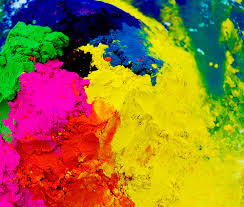Holi or Phagwa...
According to the Hindu calendar Holi or Phagwa which is
the Hindu festival of colours is
celebrated in the later part of the month of Phalgun and
the early part of Chaitra. This corresponds to the
English months of March-April. Prahalad was the son of
an evil King called Hiranyakashipu.
 This king tried
desperately to destroy this little boy and finally
resorted to an evil sister of his whose name was Holika.
Holika was immune from
destruction by fire. The evil king ordered Holika to take
Prahalad into a huge fire so that he can be burnt to death.
Prahalad's faith in God was such that Holika's powers were
reduced to nought and as such she was burnt to death whilst
Prahalad came out unhurt. It is because of this event,
that Holika or a bonfire is burnt yearly to usher in Holi.
The burning of the effigy of Holika is called Holika Dahan
and depicts how a sinner got burnt in the heat of her own
sins.
This king tried
desperately to destroy this little boy and finally
resorted to an evil sister of his whose name was Holika.
Holika was immune from
destruction by fire. The evil king ordered Holika to take
Prahalad into a huge fire so that he can be burnt to death.
Prahalad's faith in God was such that Holika's powers were
reduced to nought and as such she was burnt to death whilst
Prahalad came out unhurt. It is because of this event,
that Holika or a bonfire is burnt yearly to usher in Holi.
The burning of the effigy of Holika is called Holika Dahan
and depicts how a sinner got burnt in the heat of her own
sins.